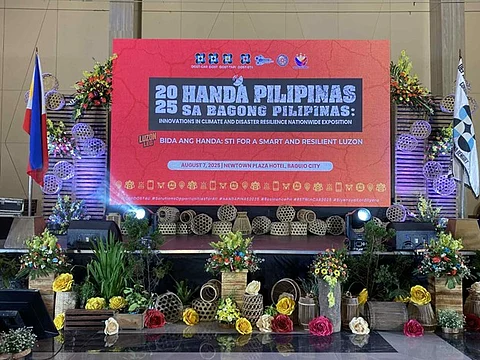
- NEWS
- the EDIT
- COMMENTARY
- BUSINESS
- LIFE
- SHOW
- ACTION
- GLOBAL GOALS
- SNAPS
- DYARYO TIRADA
- MORE

Department of Science and Technology (DOST) Secretary Renato U. Solidum Jr. stressed the importance of empowering citizens to prepare for disasters, saying that “technology alone is not enough.” He made this statement during the opening of the 2025 HANDA Pilipinas sa Bagong Pilipinas event held from 7 to 9 August at the Newtown Convention Center in Baguio City.
“This means that when communities understand the risks and have the tools and knowledge to act, they become stronger and safer,” Solidum said.
The event showcased local technologies that Local Government Units (LGUs) can adopt to better prepare for and respond to natural hazards such as earthquakes, landslides, floods, volcanic eruptions, and forest fires.
Baguio City Vice Mayor Faustino Olowan emphasized the role of science in disaster preparedness. “In this era of increasing climate threats, environmental uncertainties, and fast-evolving challenges, science and innovation are no longer optional,” he said. “They are imperatives for survival and sustainability.” Olowan also highlighted the city’s exposure to extreme weather, citing recent landslides and flooding due to heavy rains in Baguio and nearby Benguet.
Among the technologies highlighted was GeoRiskPH, an online platform mapping hazards like active fault lines, flood zones, and landslide-prone areas. “GeoRiskPH is more than just a data collection and repository; it’s a governance platform that fosters collaboration across sectors and provides clear guidance for decision-makers in a transparent, systematic, and efficient manner,” Solidum explained.
The Cordillera Regional Land Use Committee recently adopted GeoRiskPH for advanced hazard mapping and risk analysis to support safer regional planning and infrastructure development.
Other community-based innovations presented included Dynaslope, which uses sensors to detect early signs of landslides; Project SARAI, providing climate-smart agriculture advisories to farmers; and Project DANAS, a disaster risk communication toolkit available in local languages.
DOST also distributed resources such as the HANDA Pilipinas Local Caravan Guidebook, exhibit modules, and the Seismic Hazard Atlas to provincial LGUs in CAR and Baguio City, aiming to strengthen awareness campaigns and education.
The event also launched the Cordillera DREAM (Disaster Risk Evaluation, Analytics, and Management) Project, which uses big data and artificial intelligence to enhance risk analytics and disaster management in the region.
Immediately following the event, the 2025 Regional Science, Technology and Innovation Week (RSTW) in CAR commenced, showcasing local scientific advancements in food, textiles, and health from DOST research institutes and academic partners. Highlights include interactive exhibits such as the DOST-PAGASA Mobile Planetarium, a Disaster Risk Reduction Escape Room, and NuLab: STEM in Motion, a mobile laboratory for students.
Key RSTW activities also featured the launch of the Advanced Manufacturing Center in CAR, the DOST-Benguet Innovation Hub, and the turnover of Mountain Engineering Technologies to LGUs.
Both HANDA Pilipinas sa Bagong Pilipinas and RSTW are part of DOST’s initiatives to provide science-based, innovative, and inclusive solutions under the strategic pillars of human well-being, wealth creation, wealth protection, and sustainability — all aligned with the OneDOST4U mantra: Solutions, Opportunities for All.
For more information, visit www.dost.gov.ph.
